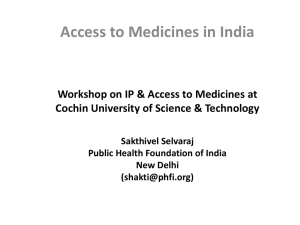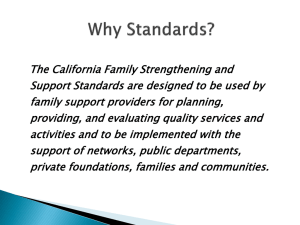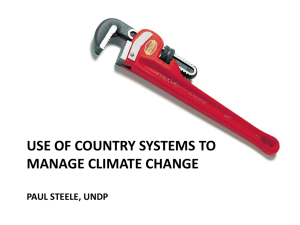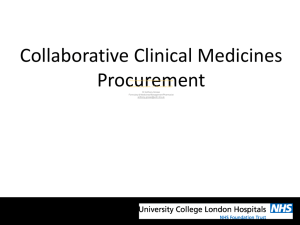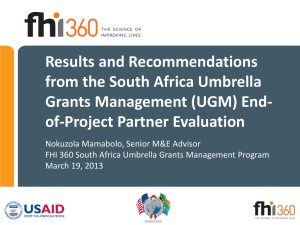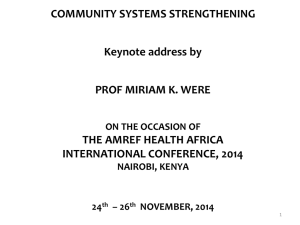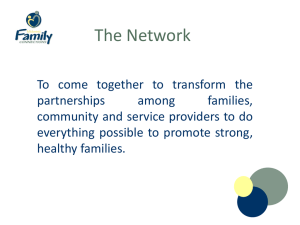Drugs_CEA
advertisement
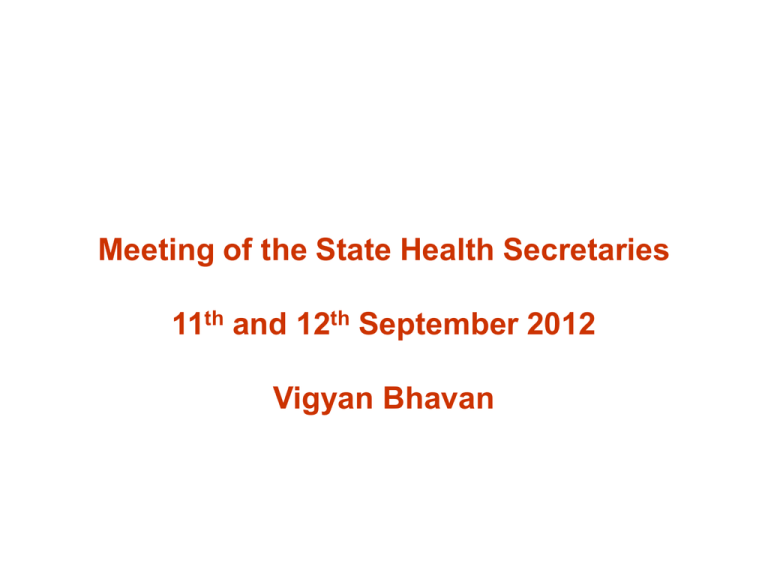
Meeting of the State Health Secretaries 11th and 12th September 2012 Vigyan Bhavan Structure of Presentation • ‘Initiative’ for Free Essential Drugs at Public Health Facilities – New Scheme • Strengthening of the Drugs Regulatory Mechanism :» Central Level – Ongoing » State Level – New Scheme • Clinical Establishment Act Free Drugs at Public Health Facilities – New Scheme • Rationale India has one of the highest figures for out of pocket (OOP) expenditure as a proportion of total health expenditure. The Planning Commission too accepts that OOP to pay for healthcare costs is a growing problem in India. It says 39 million Indians are pushed to poverty because of ill health every year. The WHO's World Health Statistics 2012, , states that almost 60% of total health expenditure in India was paid by the common man from his own pocket in 2009. Free Drugs at Public Health Facilities – New Scheme Rationale ( contd.) In Nepal's OOP health expenditure stands at (49%), Sri Lanka (44%), Indonesia (41%), Maldives (28%), Thailand (15%) and Bhutan (13%). In comparison, only 7% of France total health expenditure in 2009 was OOP, the Netherlands (6%), Monaco (7%), the UK (10%), Ireland (12%), Denmark and Germany (13%), Norway (15%), Sweden (17%) and Italy (20%). The WHO had earlier said that 3.2% Indians would fall below the poverty line because of high medical bills with about 70% of Indians spending their entire income on healthcare and purchasing drugs. Free Drugs at Public Health Facilities – New Scheme • Present Scenario • MoHFW is procuring and supplying drugs ( RCH, TB and Malaria) • Funds are made available to the States under NRHM for procurement of drugs • States procure drugs out of their own funds • Some States like Tamil Nadu, Rajasthan etc have a Free Drugs Scheme for those who seek care in PHFs Free Drugs at Public Health Facilities – New Scheme Addressing Concerns Access and Affordability • The High Level Expert Group report on Universal Health Coverage instituted by the Planning Commission of India states, "We estimate that an increase in the public procurement of medicines from around 0.1% to 0.5% of GDP would ensure universal access to essential drugs, greatly reduce the burden on private out-of-pocket expenditures and increase the financial protection for households." Free Drugs at Public Health Facilities – New Scheme The Model • To adapt the Tamil Nadu Govt.’s model of bulk purchase of drugs from the manufacturers based on Essential Drugs List and to supply free medicines to patients who seek care in PHF’s • The Central share required for free supply of medicines to be would be Rs 20000 crore. The sharing pattern under NRHM between Centre and States would be followed. • States would be advised to set up TNMSC like institutions for procurement of free medicines under generic names for free supply at the Public Health Facilities. • States shall have to contribute their share for supply of free medicines up-front • One time Capital Cost of warehouse/IT systems to be borne by the Centre Procurement • The ‘Initiative’ articulates a transparent procurement system to bring in efficiency gains and also to ensure purchase of quality essential medicines at competitive price. • All procurement shall follow a two-stage process of technical pre-qualification and price bid. • All manufacturers shortlisted for medical supplies will need to have GMP certificate, minimum annual turnover and market standing certificate. Procurement (contd) • The suppliers should not have been black listed earlier for quality failure. • It is also proposed to have a quality reporting system to test quality, safety and efficacy of medicines. • Procurement to be made directly from the manufacturers and supplied through an IT enabled supply chain management system to the public through district warehouses. Critical Interventions States to put in place mechanisms for Rational Use of Drugs through generic prescription and following STGs. States need to have an EDL. States will follow Standard Treatment Guidelines. IEC to create awareness about the Initiative Capacity building of the Officials. Monitoring and Social Audit Oversight of Rogi Kalyan Samitis. States to conduct independent sample surveys. For subsequent release of funds, utilization certificates would be required along with audit reports. Displaying names of medicines available ( Local Language) along with contact details of the Nodal Person Maintenance of a facility based Complaint/Suggestion Register to be audited by the Head of that facility periodically. Information Required from States • State/UT Governments were requested to provide data regarding budgeted amounts for free supply of drugs and expenditure made out of that amount. • State/UT Governments of Bihar, Maharashtra, Karnataka, Manipur, Meghalaya, Lakshadweep, Punjab, Delhi, Uttar Pradesh, Jammu and Kashmir, Arunachal Pradesh, Daman & Diu and Jharkhand have not responded. • Responses received from State/UT Governments of Andaman & Nicobar Islands, Uttrakhand, Andhra Pradesh, Himachal Pradesh, Mizoram, Sikkim, Chandigarh, Chattisgarh and Madhya Pradesh are not in the format. Per Capita Expenditure on Drugs by 12 States/UTs Per capita Expenditure (in Rs.) 200.00 150.00 158.93 100.00 50.00 0.00 36.27 57.44 56.40 29.74 13.72 12.46 38.31 19.28 24.07 6.38 18.11 Per capita Expenditure (in Rs.) Per capita Expenditure (in Rs.) Strengthening Drugs Regulation Challenges– Centre and the States The Drugs Regulatory Mechanism at the Centre and in the States regulates a Rs.1.3 lakh crore drug industry, Blood Banks and Clinical Trials. There are several implementation challenges which need to be overcome by :- • Strengthening manpower at the Centre and the State level. • Strengthening infrastructure at the Centre and the State level • Reviving non operational / partly operational testing facilities at the State level • Providing training to enforcement officials • Creating data base on Drug Regulation • Introducing IT enabled services. Strengthening Drugs Regulation Challenges– Centre Globalization has fundamentally changed the environment for regulating drug products and created unique regulatory challenges for CDSCO for the following reasons: • More foreign manufacturing facilities supplying bulk Drugs, Medical Devices, Blood Products, Diagnostics, Anti Cancer drugs to India. • Increasing volume of imported Medicinal Products • Greater complexity in supply chain • Imports coming from countries with less developed regulatory system • Export of Medical Products from third countries with “Made in India” tag to countries tarnishing image of the Indian industry as well as the Regulator • Track and trace technologies Central Level - Strengthening of CDSCO (On going): Manpower and Infrastructure • Creation of additional posts to comply with the recommendations of Dr. Mashelkar Committee Report (One Drugs Inspector for 50 manufacturing units and One Drugs Inspector for 200 sale premises) • Setting up of new CDSCO offices • Creation of new drugs testing labs., and upgradation of existing labs. • Regulation of Clinical Trials • Regulation of Medical Devices Central Level - Strengthening of CDSCO (On going): contd. • Mobile Drugs Testing Labs to check spurious drugs • Co-ordination with the Departments of Commerce and Industrial Policy and Promotion • Establishing an e-Governance system with IT Enabled Services for Networking, Registration and Archiving • Strengthening the Pharmacovigilance Programme of India to capture Adverse Drugs Reactions • New Drug/Medical Devices Advisory Committees to assist the DCG(I) Strengthening of Drugs Regulatory System in States – (New Scheme): Background • States grant/renew drugs manufacturing licenses • They have a major role in enforcement • States have inadequate infrastructure, both physical and human resource • States have inadequate resources for strengthening the Regulatory System Strengthening of Drugs Regulatory System in States – (New Scheme): Challenges • Sharing intimation about sub-standard drugs with the drugs controllers of other State/UTs. • Regulatory oversight over manufacturing units. • Regulatory oversight over retail sales shops selling drugs. • Capacities of State Laboratories inadequate. • Advertisements through media for both scheduled and the prohibited drugs. Strengthening of Drugs Regulatory System in States – (New Scheme): Challenges • Setting up of Designated Courts for speedy trials (only 14 States/Uts – AP, Bihar, Delhi, J&K, Karnataka, MP, Arunachal Pradesh, D&D, D&NH, Goa, Meghalaya, Mizoram, Lakshadweep, Tripura have set up such Courts) • Licensing of FDCs and other new drugs without the approval of the DCG(I)::Direction u/s 33 P of the Act • Samples drawn by the States/UTs have remained stagnant for the last few years @ 38000 – 40000 per annum. Strengthening of Drugs Regulatory System in States – (New Scheme): contd. Recommendation • Considering the above it is proposed to have a Centrally Sponsored Scheme (CSS) to strengthen the infrastructure both Physical And Human Resource in the States. Action • State/UT Governments have been requested to provide data regarding availability of infrastructure (manpower & physical) and state their requirements. The Clinical Establishments (Registration & Regulation) Act, 2010 Clinical Establishment Act, 2010 • Passed by Parliament in August 2010 and notified on 1st March, 2012 • National Council for Clinical Establishments notified on 19th March, 2012 • Central Rules notified on 23rd May, 2012 (Section 52) • Model State Rules required under (Section 54) the Act have been circulated among the States/UT’s • The implementation of this Act is being monitored by the PMO. Hon’ble Health Minister has requested the Chief Ministers to adopt and implement the Act. Applicability • States - Arunachal Pradesh, Himachal Pradesh, Mizoram and Sikkim • Union Territories - Andaman & Nicobar Islands, Chandigarh, NCT of Delhi, Dadra & Nagar Haveli, Daman & Diu, Lakshadweep, Puducherry • States who have adopted the Act - Uttar Pradesh, Rajasthan and Jharkhand • Such other States which adopt this Act under clause (1) of article 252 of the Constitution. Salient Features & Benefits of the CEA 2010 • All clinical establishments - including diagnostic centres and single doctor clinics, across all recognized systems of medicine in both public and private sector. (exception: establishments of the Defence Forces) • Assist in compilation of reliable digital registry of all types of CE at National, State and District level available in public domain. • Standard application form has been finalized for provisional registration of clinical establishments to ensure uniformity in information being collected. • Assist government in obtaining information and data required from clinical establishments for public health interventions including outbreak and disaster management Cont’d • National Council, through multi stakeholder participation and consultative process would classify clinical establishments into different categories and determine uniform minimum standards. • Permanent registration would be undertaken after categorization, classification and development of minimum standards • Provisional registration, through a process of self declaration, without any inspection. Cont’d • Application for registration by post, in person or online • Mandatory for every clinical establishment to provide treatment “within the staff and facilities available” to stabilize the emergency medical condition of any individual brought to such establishment [Sec-12(2)] • Establishment of multi stakeholder institutional bodies 1. National Council of Clinical Establishments 2. State Council / Union Territory Council of Clinical Establishments 3. District Registering Authority Cont’d • Contravention of any provision shall be punished with monetary penalties •Details of charges, facilities available would be prominently displayed at a conspicuous place at each establishment • Cancellation of registration, would occur at any time, if conditions for registration are not compiled Website Ensure transparency through online system of registration and information in the public domain Financial Support • Financial support proposed under NRHM • Coordinators at State / UT & each District level • Administrative Asst.-cum-DEO at State / UT & each District level • Computers and Printers • Meetings of State / UT Councils & District Registration Authorities • Workshops - Dissemination and Capacity building • Operational Expenses at State and District level Action to be Taken Where CEA 2010 is Applicable • State Rules under Section 54 of the Act to be notified • State / Union Territory Council of Clinical Establishments to be notified • District Registration Authorities in all districts to be notified • Provisional registration to begin • Nodal officer with a team at the state level to be notified for the implementation of the Act • IEC • Monthly progress report to the MOHFW on the status of the implementation of the CEA 2010 Where CEA 2010 is presently Not Applicable Adopt the CEA 2010 by passing a resolution in the State assembly States Having Legislation Repeal the Existing Act and Adopt the CEA 2010 by passing a resolution in the state assembly Thank You
